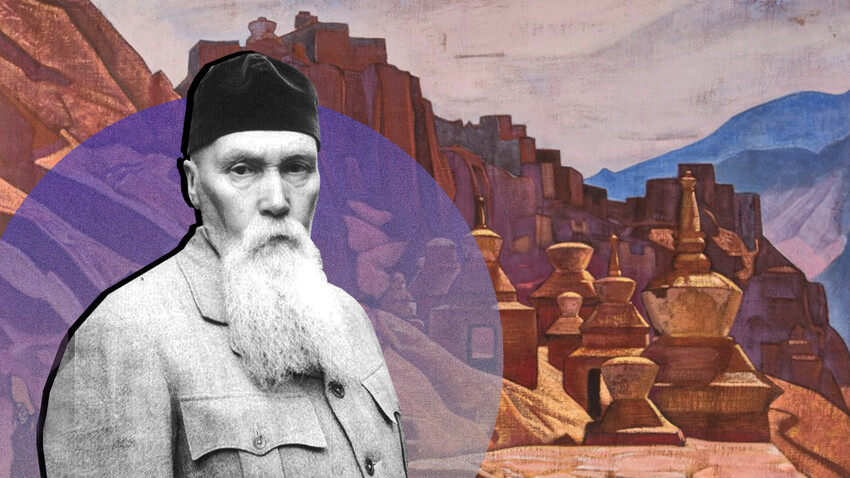

The great artist spent his childhood and youth in St. Petersburg. During the summer, he would travel with his family to their Izvara Estate where he took part in excavations of local burial mounds and researched the legends associated with them. Also during that time, he conceived his first works of art, including the painting “The Messenger”, which is about the enmity of Slavic tribes. For this canvas Roerich was awarded the title of "Artist" by the Imperial Academy of Arts, and collector Pavel Tretyakov acquired it for his public gallery.

A pupil of Arkhip Kuindzhi and graduate of the Imperial Academy of Arts, in the fall of 1900 the artist traveled to Paris to study at the art school of Fernand Cormon. The French master was the first to see the sketch of the painting “Overseas Guests”. A few years prior to that, Roerich had made a journey following the Novgorod trade route, imagining how Varangian boats had sailed past the important city in olden times.

In 1903, the artist traveled to the estate of Princess Tenisheva where he was asked to design the interiors of the main house. The Church of the Holy Spirit made a strong impression on Roerich - he believed that something akin to the ancient churches of Novgorod and Rostov could be created here. And a few years later he started making wall paintings. It is believed that the artist painted “Treasure of Angels” for the burial vault of Prince Vyacheslav Tenishev. The masterpiece depicts the foundation stone of Creation which contains within it good and evil, and which is guarded by angels. The work brought the artist international acclaim and fame, and it was shown in Paris, London and Vienna. For over 10 years it was kept at the Nicholas Roerich Museum in New York City, which to this day is still open. For more information about the Roerich Museum in the U.S., read our article here.

The early 20th century saw the emergence of another facet of Roerich’s talent - he designed stage decorations and costumes for theatrical productions. His first experience in the genre was for the play “Three Wise Men” at the St. Petersburg Starinny Theater. Roerich caught the attention of, among others, the acclaimed impresario Sergei Diaghilev, who in 1909 invited him to undertake stage designs for the Ballets Russes, which toured the world. For the opera “Prince Igor”, Roerich created the costumes and several versions of set designs depicting the Polovtsian camp in dimming crepuscular light. When audiences first saw the “Polovtsian Dances” - a dance suite with chorus to music by Borodin - Diaghilev certainly felt vindicated in his choice: The European public was absolutely enchanted by the production. By 1920, it had run for a total of 500 performances. This backcloth for the “Dances” was acquired three years ago by the State Tretyakov Gallery.

In the company of his wife Elena and son Yury, Roerich set off on a trip to Asia in 1923. The countries and regions that he visited included India, China, Altai, Siberia, Tibet and Mongolia. The entire duration of this journey in which he became intimately familiar with these cultures lasted five years. During the journey, the artist painted around 500 works, including the series known as the “Maitreya Suite”, which are colorful musings about the coming of the future Buddha and the arrival of a time of peace when people will work together in ashrams for the good of mankind.

The trip to Tibet inspired the artist to make a picturesque series with spectacular mountain scenery. In late 1927, Roerich saw the Tangla range, one of the highest mountain systems in Tibet. This is where the location of Shambhala is believed to be. In 1935, the artist settled in India, remaining until his death. There, he was at the peak of his creative powers - he produced over a thousand paintings and two books, and his works were shown in the world’s most important art galleries.

The artist first turned to the subject of “Terra Slavonica” in the early 1930s. A monk looking at a landscape receding into the distance with the domes of churches on a hill - this composition is either a vision or a dream about the "Stronghold of the Union of Peoples". Roerich believed that the Slavic peoples would unite and described Russia as a "Messiah of the new age". Having left Russia before the Revolution, he made repeated attempts to return home. After 1921, the new socialist country enacted a strict border control regime, and those Russians who had left the country weren’t welcome back; but Roerich still hoped that sooner or later he would see his homeland again. Owing to his critical remarks about the Bolsheviks, Roerich was persona non grata in Soviet Russia. Still, the artist wanted to donate his paintings to the Soviet people and wrote to the People's Commissariat for Foreign Affairs and Soviet embassies abroad, but Stalin gave instructions that Roerich's letters should be left unanswered. A few weeks before his death he applied for a visa to return to the Soviet Union, but did not live to receive a reply. Roerich died in India on December 13, 1947.
Dear readers,
Our website and social media accounts are under threat of being restricted or banned, due to the current circumstances. So, to keep up with our latest content, simply do the following:
If using any of Russia Beyond's content, partly or in full, always provide an active hyperlink to the original material.
Subscribe
to our newsletter!
Get the week's best stories straight to your inbox